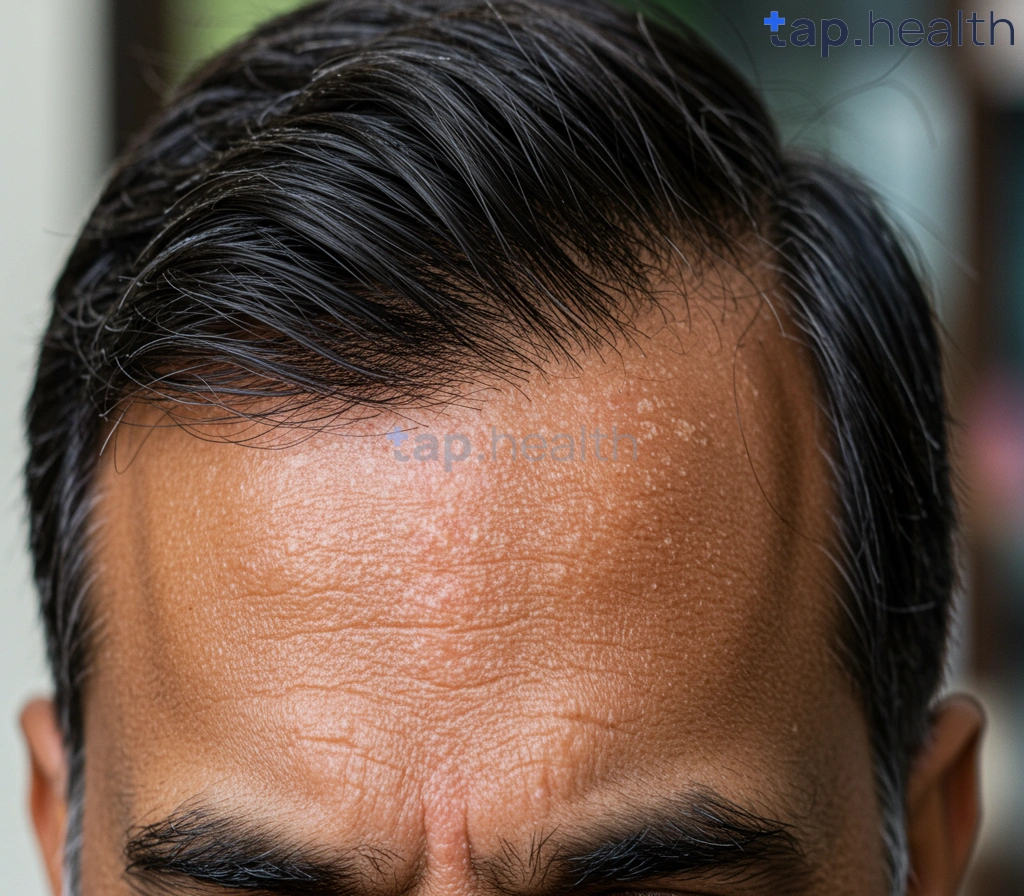Table of Contents
- Seborrheic Dermatitis & Diabetes: Understanding the Link
- Is Seborrheic Dermatitis Worse with Diabetes?
- Managing Seborrheic Dermatitis: A Guide for Diabetics
- Diabetic Skin Conditions: Recognizing Seborrheic Dermatitis
- Seborrheic Dermatitis Treatment for People with Diabetes
- Frequently Asked Questions
- References
Living with diabetes often means navigating a complex landscape of health concerns, and sometimes, that includes unexpected skin issues. One such condition that can disproportionately affect people with diabetes is seborrheic dermatitis. Understanding seborrheic dermatitis in people with diabetes is crucial for effective management and improved quality of life. This blog post will delve into the connection between these two conditions, exploring the potential causes, symptoms, and most importantly, effective treatment strategies. We’ll help you understand why this skin condition might be more prevalent in individuals with diabetes and equip you with the knowledge to proactively address any concerns. Let’s get started!
Seborrheic Dermatitis & Diabetes: Understanding the Link
Individuals with diabetes often face a heightened risk of various skin conditions, and seborrheic dermatitis is no exception. While the exact connection isn’t fully understood, several factors contribute to this increased susceptibility. The compromised immune function often associated with poorly managed diabetes can make individuals more vulnerable to yeast overgrowth, a primary trigger for seborrheic dermatitis. This yeast, Malassezia, thrives in oily areas of the skin, leading to the characteristic inflammation, redness, and flaking. For a deeper understanding of the symptoms and causes of seborrheic dermatitis, you might find our article on Seborrheic Dermatitis Symptoms and Causes – Tap Health helpful.
The Impact of Diabetic Complications
Beyond immune dysfunction, other diabetic complications may exacerbate seborrheic dermatitis. For instance, nearly 30% of people with diabetes develop diabetic nephropathy, a form of kidney disease. While not directly causing seborrheic dermatitis, kidney problems can affect the body’s overall ability to regulate inflammation and manage skin health, potentially worsening the condition. Similarly, nerve damage (neuropathy), common in diabetes, might reduce sensation, making it harder to detect and treat early signs of seborrheic dermatitis. The connection between diabetes and other health issues, such as Diabetes and Hair Loss, highlights the importance of comprehensive health management.
Managing Seborrheic Dermatitis in Tropical Climates
In hot and humid climates prevalent across India and other tropical regions, managing seborrheic dermatitis presents unique challenges. The increased heat and humidity can further irritate inflamed skin, making it crucial to prioritize gentle cleansing with mild, fragrance-free soaps. Regularly changing clothes and bedding is also essential to prevent yeast overgrowth. Staying well-hydrated and maintaining controlled blood sugar levels are key to overall health and can positively impact skin conditions.
Seeking Expert Care
Consult a dermatologist for personalized treatment plans. Early intervention is crucial for preventing complications and improving quality of life. They can recommend appropriate antifungal creams, shampoos, and other treatments suitable for your skin type and climate. Remember, effective management involves both controlling blood sugar levels and addressing the specific needs of your skin. Don’t hesitate to reach out for expert guidance, particularly if your seborrheic dermatitis is severe or persistent.
Is Seborrheic Dermatitis Worse with Diabetes?
The connection between diabetes and skin conditions is significant, especially in regions like India and other tropical countries. While not directly causing seborrheic dermatitis (SD), diabetes can exacerbate its symptoms and potentially increase complications. This is because poorly controlled blood sugar levels can weaken the immune system, making individuals more susceptible to infections and skin irritations. SD, characterized by flaky, itchy skin, often presents on the scalp, face, and other areas, potentially becoming more severe or persistent in individuals with diabetes.
Understanding the Increased Risk
High blood sugar levels can also affect the skin’s barrier function, leading to increased dryness and inflammation. This compromised barrier makes it easier for fungi like Malassezia, a primary contributor to SD, to thrive. Consequently, diabetics might experience more frequent and intense SD flare-ups, potentially leading to discomfort and reduced quality of life. The impact is further amplified by the prevalence of other complications associated with diabetes. For example, nearly 15% of diabetics experience foot ulcers in their lifetime, with high amputation risks. While not directly related to SD, these underlying conditions highlight the importance of managing diabetes effectively to minimize the risk of various health issues, including severe skin problems. This is especially important given that diabetes can also affect hair health, as explored in our article, Does Diabetes Cause Thinning Hair?.
Managing Seborrheic Dermatitis in Tropical Climates
In hot and humid tropical climates prevalent in many parts of India, managing SD can be particularly challenging. Increased sweating and exposure to environmental factors can worsen inflammation. Therefore, maintaining good blood sugar control through diet, medication, and regular exercise is crucial. Seeking timely medical attention from a dermatologist is essential for proper diagnosis and treatment. They can recommend appropriate antifungal shampoos, creams, and other treatments, including managing any co-existing skin infections that may be more easily developed with diabetes. Regular skin checks, particularly of the feet, are also vital to prevent or early detect complications. Prioritizing diabetes management directly improves the chances of managing seborrheic dermatitis effectively. It’s also important to remember that diabetes is a complex condition, and understanding its potential links to other health issues is crucial for comprehensive management. For instance, while not directly related to seborrheic dermatitis, it is important to understand the distinction between conditions like diabetes and meningitis, a topic covered in our article, Can Meningitis Cause Diabetes?.
Managing Seborrheic Dermatitis: A Guide for Diabetics
Seborrheic dermatitis, characterized by flaky, itchy skin, can be particularly challenging for individuals with diabetes. The added complexities of managing blood sugar levels often intersect with skin health, making effective treatment crucial. In India and tropical countries, where humidity and heat can exacerbate symptoms, understanding the specific needs of this population is paramount.
Understanding the Connection
Diabetes can impact skin health in various ways. One significant factor is diabetic neuropathy, a nerve damage affecting 30-50% of diabetic patients. This can lead to reduced sensation, making it harder to detect and manage skin irritations like seborrheic dermatitis. The resulting pain and reduced mobility can further complicate treatment and hygiene practices. Moreover, the compromised immune system often associated with diabetes can make individuals more susceptible to infections, potentially worsening seborrheic dermatitis. As you age, managing these challenges can become even more complex, as highlighted in our article on Managing Diabetes as You Age: Challenges and Solutions.
Practical Management Tips for Indian & Tropical Climates
Gentle cleansing is key. Use lukewarm water and mild, fragrance-free cleansers to avoid further irritation. In humid climates like those prevalent across India and other tropical regions, opt for frequent, but gentle, cleansing to prevent excess oil buildup which can worsen the condition.
Keeping cool and dry is vital. Loose, breathable cotton clothing is preferred, especially in hot and humid weather. Avoid harsh fabrics that can irritate the skin. Regularly changing clothes and bedding is also important, especially in the warmer months.
Consult a dermatologist specializing in diabetic skin conditions. They can provide tailored advice on managing seborrheic dermatitis, taking into account your specific diabetic condition and the climatic conditions you live in. Early intervention and appropriate treatment is essential for preventing complications. Remember, consistent management, tailored to your individual needs and environment, is key to improving your quality of life. For alternative treatment options, you might find our article on 14 Ayurvedic Treatment for Seborrheic Dermatitis – Tap Health helpful.
Diabetic Skin Conditions: Recognizing Seborrheic Dermatitis
Seborrheic dermatitis, a common skin condition causing flaky, itchy patches, is often more prevalent and severe in individuals with diabetes. This is because diabetes can impair the immune system and affect skin barrier function, making individuals more susceptible to infections and inflammatory skin diseases. The warmer, humid climates prevalent in many Indian and tropical countries can further exacerbate the condition, leading to increased discomfort and potential complications.
Understanding the Link Between Diabetes and Seborrheic Dermatitis
Diabetes is linked to a multitude of health complications, and skin conditions are no exception. The elevated blood sugar levels associated with diabetes can create an environment conducive to yeast overgrowth, a key factor in seborrheic dermatitis. Additionally, diabetes can weaken the immune response, making it difficult for the body to fight off fungal infections that can trigger or worsen the condition. This is particularly relevant in tropical climates where yeast and fungal growth is more common. Managing blood sugar levels effectively is crucial in preventing or mitigating seborrheic dermatitis flares. Understanding the immune system’s role is key; read more about it in our article, Are Type 1 Diabetics Immunocompromised?
Recognizing and Managing Seborrheic Dermatitis in Tropical Climates
Seborrheic dermatitis in individuals with diabetes may present as red, scaly patches on the scalp, face, and chest. It can lead to intense itching and discomfort, especially in humid environments common across India and other tropical nations. Proper hygiene, using mild, fragrance-free cleansers and keeping the affected areas clean and dry, is essential. Seeking timely medical advice from a dermatologist is crucial for accurate diagnosis and personalized treatment plans. This is especially important given the increased risk of infections and complications associated with diabetes. Remember, a well-managed diabetes regimen can significantly reduce the severity and frequency of seborrheic dermatitis outbreaks. The impact of heat and humidity can also worsen symptoms; learn more about how heat affects diabetics in our article, How Does Heat Affect Diabetics?
Seeking Help and Prevention
In India and other tropical countries, access to quality healthcare can vary. It is crucial to consult with a qualified dermatologist for personalized advice on managing seborrheic dermatitis. Early diagnosis and treatment can prevent complications and improve overall quality of life. Remember, proactive management of diabetes and consistent skincare practices are vital for preventing and minimizing seborrheic dermatitis symptoms in these regions.
Seborrheic Dermatitis Treatment for People with Diabetes
Managing seborrheic dermatitis can be especially challenging for individuals with diabetes. The condition is highly prevalent in the 20–64 age group, affecting around 61% according to the International Diabetes Federation. This age range covers a significant portion of the working population in India and other tropical countries, where hot and humid climates can worsen symptoms. Combined with the need to manage blood sugar levels, finding effective treatment becomes particularly important.
Effective Treatment Strategies
A multi-pronged approach is often the most effective. Over-the-counter antifungal shampoos containing ketoconazole or selenium sulfide are commonly recommended as the first line of defense. These are widely available in pharmacies across India and other tropical regions.
For more severe cases, a dermatologist may prescribe stronger topical corticosteroids or antifungal medications. It is crucial to discuss treatment options with a healthcare professional, particularly for individuals with diabetes, since some medications can impact blood sugar levels. For additional guidance on supporting blood sugar management, you may find our article on Safe and Effective Dietary Supplements for Diabetes Care helpful.
Lifestyle Modifications
Lifestyle changes play a key role in managing seborrheic dermatitis. Important steps include:
-
Maintaining proper hygiene and gently cleansing affected areas.
-
Avoiding harsh soaps or skincare products that can aggravate the skin.
-
Managing stress, as it can trigger or worsen flare-ups.
-
Following a balanced diet and regular exercise, which is particularly important for older adults with diabetes (39% aged 65+ according to the International Diabetes Federation).
Seeking Expert Advice in India and Tropical Countries
In humid climates, individuals with diabetes and seborrheic dermatitis should prioritize consulting a dermatologist for a personalized treatment plan. Experts can assess the severity of the condition, factor in climate-related triggers, and recommend strategies to manage symptoms while minimizing complications.
Frequently Asked Questions on Seborrheic Dermatitis & Diabetes
Q1. What is the connection between diabetes and seborrheic dermatitis?
People with diabetes are more prone to seborrheic dermatitis (SD) because high blood sugar weakens the immune system, making them more vulnerable to yeast overgrowth and skin inflammation that causes SD. Diabetic complications like nerve and kidney damage can also worsen SD.
Q2. How does diabetes management affect seborrheic dermatitis?
Effectively managing your blood sugar levels is key to reducing the severity and frequency of SD outbreaks. Good blood sugar control strengthens your immune system, helping your body fight off the yeast that contributes to SD.
Q3. What are the common symptoms of seborrheic dermatitis, and how can I treat it?
Seborrheic dermatitis causes flaky, itchy patches on the skin. Treatment involves a dermatologist consultation to get a proper diagnosis and discuss treatment options which may include antifungal medications and lifestyle changes like stress management and good hygiene.
Q4. Does climate affect seborrheic dermatitis symptoms?
Yes, hot and humid climates can worsen SD symptoms. Gentle cleansing and wearing appropriate clothing can help manage this.
Q5. What is the best approach to managing seborrheic dermatitis if I have diabetes?
Early intervention is crucial. See a dermatologist for diagnosis and treatment. Combine medical treatments (like antifungals) with good diabetes management (blood sugar control), proper hygiene, and stress management for the best results.
References
- A Practical Guide to Integrated Type 2 Diabetes Care: https://www.hse.ie/eng/services/list/2/primarycare/east-coast-diabetes-service/management-of-type-2-diabetes/diabetes-and-pregnancy/icgp-guide-to-integrated-type-2.pdf
- Diabetes Mellitus: Understanding the Disease, Its Diagnosis, and Management Strategies in Present Scenario: https://www.ajol.info/index.php/ajbr/article/view/283152/266731



